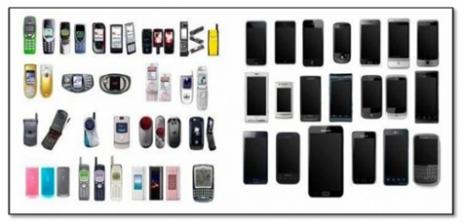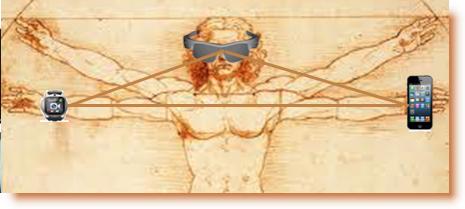The smartphone is becoming a commodity, a lifecycle stage where the strong get stronger, the weak get weaker, and the products standardize and start to look alike. This dynamic is driving innovation in existing products to extremes and spawning a new class of wearable devices.
Today two major players are leading the mobile hardware market, chased by a gaggle of wannabes fighting desperately for third place. The weaker players are getting acquired or are facing worse fates. The “insanely great” inventions of the Jobs Era (i.e., iPhone, iPad, and Mac Air) are being aggressively emulated. The before-and-after picture below tells the story.
 Smartphones before (left) and after the Apple iPhone
Smartphones before (left) and after the Apple iPhone
Meaningful differentiation in smartphones and tablets is extremely difficult now for three simple reasons. Operating systems have narrowed to a small handful of solutions that basically do the same thing. Processor makers are engaged in a performance arms race, but the practical result has been hardly more than a narrow range of mostly similar products. Radios, by definition, adhere to standards, leaving OEMs with implementation advantages that quickly evaporate.
In this situation, most competitors are pursuing or will pursue a two-track mobile strategy. They are creating completely new platforms such as wearables, while they take the existing black rectangle format to extremes.
Emerging wearable devices are gaining momentum with new and somewhat exotic form factors. Popping up before our eyes is an array of watches, glasses, fitness bands, smart-clothing, sensors in shoes, sensors that are swallowed, tattooed sensors, and implanted sensors.
We are probably on the verge of a Cambrian explosion in the wearable market where a wide diversity of products may swamp the market and have to fight for survival. Due to diversity, the wearable market will likely be highly fragmented, making it difficult for any one type of device to re-create the growth of the smartphone market. Only the most aggressive market forecasts show the wearable market being up to 20 percent the size of the smartphone market in five years.
The likely evolution of wearables will be that they become part of an integrated user platform with the smartphone at the center acting like a personal hub of whatever the user bears or wears. The elements of such an integrated wearable platform are already appearing.
A personal, mobile ecosystem is evolving. Watches will be used to control glasses and phones and act as skin-contact biosensors collecting real-time data on the wearer. Images from the glasses will be transferred to the phone for processing, or the glasses will connect directly to the cloud, depending on where the radio is integrated. Messages received by the phone will be displayed in the glasses or on the watch.

High-end phones and tablets will likely remain the main targets for innovation as they evolve together with wearables. Phone and tablet makers will drive the features of the black rectangle design to extremes to make them more secure, run faster, last longer, sound better, look cooler, provide higher resolution, support all kinds of new accessories, and in general push the limits of human imagination.
Many of the new features will be integrated with, and be portals to, new services. Two excellent examples of imaginative new services that are coming are augmented reality and context awareness. Another coming service will surely be sensor-based, highly accurate, indoor, location-based services. Yet another is likely to be bio-sensor-based telemedicine as a shortage of non-primary care specialists is expected to double to 64,800 by 2025 up from a projected shortage of 33,100 by 2015.
— Bill Boldt is a marketing executive and market researcher.
lang: en_US
Share this post via:







Flynn Was Right: How a 2003 Warning Foretold Today’s Architectural Pivot